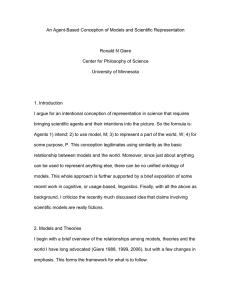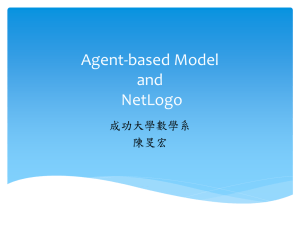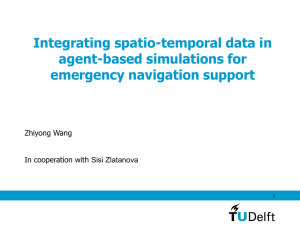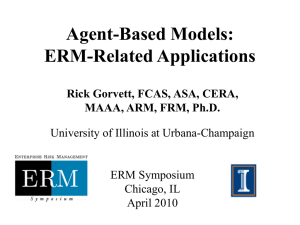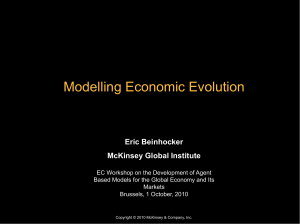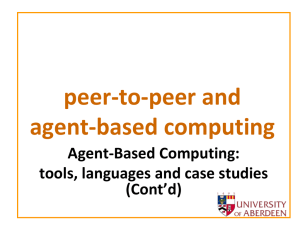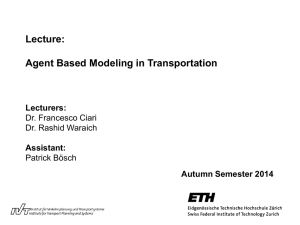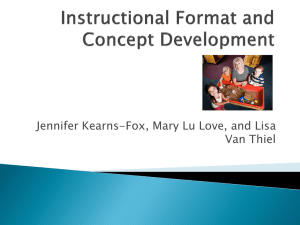An Agent-Based Conception of Models and Scientific Representation
advertisement
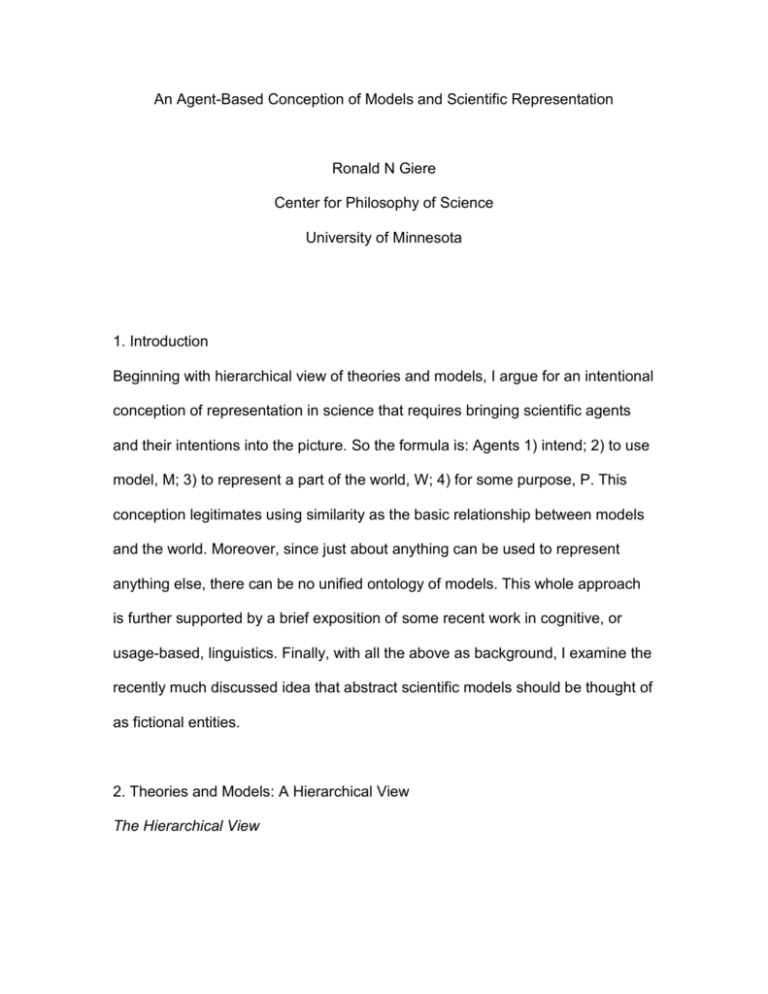
An Agent-Based Conception of Models and Scientific Representation Ronald N Giere Center for Philosophy of Science University of Minnesota 1. Introduction Beginning with hierarchical view of theories and models, I argue for an intentional conception of representation in science that requires bringing scientific agents and their intentions into the picture. So the formula is: Agents 1) intend; 2) to use model, M; 3) to represent a part of the world, W; 4) for some purpose, P. This conception legitimates using similarity as the basic relationship between models and the world. Moreover, since just about anything can be used to represent anything else, there can be no unified ontology of models. This whole approach is further supported by a brief exposition of some recent work in cognitive, or usage-based, linguistics. Finally, with all the above as background, I examine the recently much discussed idea that abstract scientific models should be thought of as fictional entities. 2. Theories and Models: A Hierarchical View The Hierarchical View Giere. An Agent-Based …. p. 2. Figure 1 provides a sketch of relationships among theories, models, and the world that is both hierarchical and principle-centered.1 In this schema, statements that are often taken to constitute theories function here to define the principled models. Such statements are automatically true of the principled models. To invoke a canonical example, what are called “Newton’s Laws of Motion” are for me principles that define a class of highly abstract models (principled models) and thus characterize a particular mechanical perspective on the world. Newton’s Laws are not “Laws of Nature” in the sense of universal generalizations over things in the world. They cannot by themselves be used to make any direct claims about the world. They don’t “represent” anything. Principled Models Principled Models Representational Models Representational Models Specific Hypotheses Generalizations Specific Hypotheses and and Generalizations Models of Experiments and Data Models of Data The Experiments, TheWorld, World (including data)and Data Figure Figure 1. 1. By adding conditions and constraints to the principled models one can generate families of representational models that can be used to represent things in the world. Continuing the example, by adding Newton’s gravitational law one can generate representational models of two body interactions in three dimensional Giere. An Agent-Based …. p. 3. space. Adding further conditions one eventually one gets to a fully specified model of some particular real two body system such as the Earth and the Moon.2 Note that here what is usually called Newton’s “Theory” consists only of the statements of the three laws. These alone define the principled models. The Law of Universal Gravitation is thus not a part of the core theory. It constitutes a specification of a kind of representational model. Other specifications include linear motion in a uniform gravitational field (a falling body) and a linear restoring force (a harmonic oscillator). Thus the hierarchy of models for classical mechanics is in fact a multiple hierarchy defined by various possible force functions. Once a force function is added, the concept of force itself drops out of the specification of a representational model, replaced by such things as mass, distance and friction. Figure 2 is a schematic rendering of the top part of this multiple hierarchy. From now on I will presume this multiplicity.3 Principled Models Specific Conditions F = - mg F = - kx F = - G m 1 m2 / r 2 ... Representational Models Specific Hypotheses and Generalizations Figure 2. Giere. An Agent-Based …. p. 4. How does one connect abstract models to specific real physical systems? This requires at least two processes which I call “interpretation” and “identification” (Giere, 1988, pp. 74-76). For interpretation, elements of an abstract principled model are provided with general physical interpretations such as “mass,” “position,” and “velocity.” Such interpretations are already present in the statements that define the principled models. Scientists do not begin with an “uninterpreted” formalism and then “add” interpretations. For identification, elements of a representational model are identified (or coordinated) with elements of a real system. Do we, as theorists of science, need to give a more detailed account of the processes of interpretation and identification? I think not. We can pass this job off to linguists and cognitive scientists. We know it can be done because it is done. That is enough for our purposes. A “hypothesis” is a claim (statement) that a fully interpreted and specified model fits a particular real system more or less well. So an interpreted representational model of two moving bodies under gravitational attraction can be fully specified by designating one body as the Earth and the other as the Moon with their respective masses, positions and velocities. One can, of course, also generalize hypotheses to include, for example, other planet-moon systems in the Solar System. Fully specified representational models are tested by comparison with models of data, not directly with data, which are part of the world. So it is a model-model comparison, not a model-world comparison. The move from data to models of data requires models of experiments and involves statistical and other Giere. An Agent-Based …. p. 5. data processing techniques, empirical information from other sources, and many other things in addition. Once again, a more detailed version of Figure 1 would include the complexities of moving up from data to models of data. I am, of course, aware that scientists and others use such terms as “principle,” “theory,” “law,” “model,” and “data” in various ways, not always consistently. So I am regimenting the use of these terms in the interest of developing a systematic account of a component of scientific practice. I think my scheme does capture a significant part of scientific practice. And most of what scientists and other theorists of science want to say about this practice can be accommodated within my framework. I earlier described the hierarchical relationship between models and the world represented in Figure 1 as “principle-centered.” I also embrace several other less principle-centered views. Figure 3 shows a multiple principle view. Here diverse principled models are employed together to create representational models. The principles employed need not even be consistent. I once described a model of a nuclear potential defined by an equation with two terms. 4 The first term employed principles from non-relativistic quantum theory. The second term was a “correction term” employing principles from relativistic quantum theory. Technically, this equation is logically inconsistent. Yet the physicists involved had no difficulty working with the resulting model. Nor is this at all an unusual situation in the sciences. Giere. An Agent-Based …. p. 6. PM1, PM2, …PMn Representational Models Specific Hypotheses and Generalizations Models of Experiments and Data The World, Experiments, and Data Figure 3. Figure 4 depicts yet another possibility for relationships between models and the world. Here there may be no “higher” principles at all, and thus no “theory.” Representational models may be constructed from models of the data plus other empirical models and a variety of mathematical techniques. “Phenomenological” models provide a good example of this possibility. So do some simulation models.5 Representational Models Specific Hypotheses and Generalizations Models of Experiments and Data The World, Experiments, and Data Figure 4. Giere. An Agent-Based …. p. 7. Model and World Now we can ask: what is the desired relationship between a representational model and the world? My view is that, for moderately complex models, especially ones defined in terms of continuous functions, claims of perfect fit cannot be justified. More precisely, the only model that might be claimed to exhibit a perfect fit to the world would have to be a model that fit everything perfectly. Here is the argument. Consider a representational model that does not apply to everything. Then the things to which it does not apply might have causal connections to the things that are represented. But we cannot know what all those possible connections might be. So, the only candidate model that could justifiably be claimed to be a perfectly fitting model of anything would have to be a model of everything. The prospects for creating any such model are nil. Note that, in this discussion, “fit” means “total fit,” that is, the fit of most or all the elements of the representational model to aspects of the world, not just fit between a representational model and a model of the data. At least for quantitative models, the above argument also rules out characterizing the desired relationship between representational models and the world as isomorphism (or partial isomorphism). That would be the same as perfect fit (or partial perfect fit). Nor can we invoke truth as the desired relationship between models and the world. Whether abstract or physical, models are objects, not linguistic entities, although abstract models may be defined using linguistic resources. So, Giere. An Agent-Based …. p. 8. assuming that truth and falsity are properties only of linguistic entities, models themselves are not even candidates for truth or falsity. On the other hand, hypotheses, that is, claims that a model fits the world more or less well are linguistic entities and so can be true or false. So can claims about the relative fit of aspects of a model, such as the period of the Moon’s orbit around the Earth. Here, however, “truth” must be understood in its vague, every day sense, and not as “exact truth.”6 I think that claims of “imperfect fit” or “vague truth” are equivalent to claims of similarity between a model and a real system. Of course this relationship must be qualified at least in terms of respects and degrees, and, as will be argued in more detail below, those qualifications must be intentionally specified. So, I still maintain that the desired relationship between models and the world is similarity (or “fit”, etc.). Once one adopts similarity as the desired relationship between models and the world, one automatically gets an account of what is usually called abstraction or idealization. Representational models are by their very nature abstract and idealized. Another advantage of invoking intentional similarity as the desired relationship between models and the world is that one’s understanding of both abstract and concrete models (e.g., Watson’s tin and wire model of DNA) is the same. No separate account of representation using concrete models is required. 3. Scientific Representation: An Intentional Conception Giere. An Agent-Based …. p. 9. I have called some models “representational,” but I have not yet said what makes a model a representation of something in the world, or how some models represent things in the world. I have already said that representation with models cannot just be a matter of a similarity between a model and the thing modeled. There are two major reasons why this is so. First, we need to know which similarities matter. That there will always be some similarities is vacuously true. Second, as Suárez (2004) has emphasized, similarity is a symmetrical relation while representation is asymmetrical. If we add the intensions of an agent or agents, both of these problems disappear. The formula is: Agents 1) intend; 2) to use model, M; 3) to represent a part of the world, W; 4) for some purpose, P. So agents specify which similarities are intended, and for what purpose. This conception eliminates the problem of multiple similarities and introduces the necessary asymmetry. I propose to call this “The Intentional Conception of Scientific Representation.”7 It will be noted that this conception presupposes a notion of representation in general. I doubt that it is possible to give a non-circular (or reductive) account of representation in general. The intentional conception of representation using models is most clearly seen in the case of idiosyncratic models. I once saw a nuclear physicist use a pencil to help explain how a beam of protons could be spin polarized. Using the pencil to represent the beam, he pointed it in a shallow slant toward the middle of a table explaining that protons hitting the surface at a glancing angle would mostly spin forward just like tennis balls hitting the court after being served. No Giere. An Agent-Based …. p. 10. actual tennis ball was present. There is clearly no intrinsic representational relationship between a pencil and a beam of protons. Of course, the shape of a pencil makes it appropriate to use for representing a beam of protons. But that similarity has to be invoked. It is not by itself what makes the pencil a representation of a beam of protons. The same goes for the imagined tennis ball. Because of the usual focus on conventional symbolic means for representation, we typically fail to notice the intentional aspect of symbolic communication. So the picture, on a standard conception, seems to be that shown in Figure 5. MODEL represents OBJECT Figure 5. Here the model somehow “directly” represents the object. On the intentional conception, by contrast, the picture is more complex, as show in Figure 6. MODEL OBJECT Agents Intend to Use PURPOSE To Represent For Figure 6. Giere. An Agent-Based …. p. 11. Among intentional acts of representation, one cannot make a sharp distinction between those that are “successful” and those that are “unsuccessful.” The most experimental methods can reveal is how well a model fits various aspects of its intended target. How well is “well enough” may depend on individual or communal understandings of current standards in force in particular scientific specialties, or on the purpose for which a model is being employed. Invoking an intentional conception of models and representation might seem to be an ad hoc maneuver designed to save the role of similarity in scientific representation. There are, however, philosophical precedents in the works of Wittgenstein and Paul Grice (1969). Fortunately, there is also a general approach to language and linguistics that provides a solid foundation for the intentional view. One version goes under the name of “cognitive linguistics” as practiced, for example, by George Lakoff (1987). In this paper I will invoke Michael Tomasello’s “Usage Based Theory of Language.” 4. A Usage-Based Theory of Language I regard Michael Tomasello’s Constructing a Language: A Usage-Based Theory of Language Acquisition (2003) as currently the best version of this nongenerative, indeed, explicitly anti-Chomskian, theory of language. As one can see from the title, he presents his account as a theory of “language acquisition” rather than language in general. In line with this orientation, the book contains discussions of many empirical studies of the early acquisition of various components of language. I will not comment on these aspects of his work since it Giere. An Agent-Based …. p. 12. also serves as a theory of language in general because it implicitly includes an account of what is learned. This all applies especially well to our case because learning a science, or a new approach to an established field of inquiry, is partly a matter of acquiring new additions to one’s native language. Tomasello sometimes refers to his “usage-based linguistics” as “cognitivefunctional linguistics.” Thus, he claims that “someone uses a piece of language with a certain communicative function, and so we may say that that piece of language has a certain function” (3). He also thinks of language learning “as integrated with other cognitive and social-cognitive skills.” He emphasizes two sets of skills which he claims “basically define the symbolic or functional dimension of linguistic communication—which involves in all cases the attempt of one person to manipulate the intentional or mental states of other persons.” The first of these is “intention-reading,” which has several components (3). 1) “The ability to share attention with other persons to distal objects of mutual interest.” 2) “The ability to follow the attention and gesturing of other persons to distal objects and events outside the immediate interaction.” 3) “The ability to actively direct the attention of others to distal objects by pointing, showing, and using of other nonlinguistic gestures.” The second skill is “pattern finding,” which also has several components (4). Giere. An Agent-Based …. p. 13. 1) “The ability to form perceptual and conceptual categories of ‘similar’ objects and events.” 2) “The ability to form sensory-motor schemas from recurrent patterns of perception and action.” 3) “The ability to perform statistically based distributional analyses on various kinds of perceptual and behavioral sequences.” Tomasello claims that both sets of skills “are evolutionarily fairly old, probably possessed in some form by all primates at the very least” (4). In addition, he claims that pattern finding skills are “domain-general, in the sense that they allow organisms to categorize many different aspects of their worlds into a manageable number of kinds of things and events … (4).” Figure 7 is a version of Tomasello’s picture of his overall schema. Here speakers direct their attention to a hearer with the intention that hearers direct their attention both to the speaker and to some particular state of affairs. In Giere. An Agent-Based …. p. 14. Joint Attentional Frame Speaker M W Hearer That M be taken as a model for W Attention Figure 7. Intention Tomasello’s picture, the state of affairs is typically a visible object of some sort, although it could also be a visible process. In my version, the state of affairs is more abstract. Here speakers intend that hearers should understand that they are being asked to consider (or believe, etc.) the claim that M is to be taken as a model of W. This sort of situation sometimes exists in actual scientific practice when a speaker addresses one or more hearers in person. More often, of course, a scientist is addressing colleagues through some medium, such as a publication. One should compare Figure 7 with my picture of the intentional conception of scientific representation in Figure 6. The main difference between these two pictures is that the cognitive-functional conception of language emphasizes the communicational functions of language. The communicational function, however, Giere. An Agent-Based …. p. 15. is there in my intentional account, even if the audience is not immediately present but only potentially present as readers of a scientific paper. This usage-based theory of language has the great advantage that it makes it possible to understand how language could have evolved in humans without positing an underlying universal grammar for which there seems no plausible evolutionary just-story.8 It contrasts strongly with the view that language is a kind of logic. Indeed, on a usage-based account, syntax is not the foundation for a language, but emerges through practice by a process called “grammaticalization.” This enough about a usage-based approach to language to show that introducing intentions into our conception of how models may be used to represent parts of the world is not ad hoc, but in line with a growing movement in the study of language which links it to other cognitive process studied in the cognitive sciences. 5. Models and Fictions There has recently been much talk about the relationship between models and fictions.9 Discussion of this relationship has often taken the form of a question: “Are Models Fictions”? I find this way of framing the issue misleading. It may easily be understood as presupposing that the prior questions, “What is a model?” and “What is a fiction?” have definite answers. Given the variety of things that can be used as models, the first question has no simple answer. I presume the same is true of the second question. So one cannot simply inspect Giere. An Agent-Based …. p. 16. the answers to the latter two questions and read off an answer to the original question. Thus, I would frame the original question as whether it is useful for the project of understanding scientific practice to think of some standard sorts of models as being like prototypical fictions. It is important at the outset to emphasize the distinction between the ontology of models and the functions of models.10 Turning first to ontology, there is obviously no problem with the ontology of physical models such as Watson and Crick’s original tin and wire model of DNA. The ontology of more abstract models such as The Simple Pendulum is more problematic. It is tempting to assimilate such models to mathematical entities since their abstract structure is defined mathematically (F = - kx). But this would not work for all abstract models. The geological models of Plate Tectonics are equally abstract but qualitative. 11 At this point one might be tempted to seek a general theory of abstract entities, perhaps distinguishing different kinds of abstract entities. Then one might wonder what might be the relation between the length of a wire supporting a bob in a real pendulum and the length of the support in an abstract simple pendulum. Do we have one property (length) or two (real length and abstract length)? 12 I would suggest philosophers of science do not need an answer to such questions. There is a simpler view that, in fact, associates the ontology of abstract scientific models with that of works of fiction. Rather than asking whether models are fictions, we can ask whether fictions are models. Here, regarding ontology, the answer can be positive. Take a quintessential work of fiction, such as the novel War and Peace. In writing this Giere. An Agent-Based …. p. 17. work, Tolstoy can be regarded as having created an elaborate possible world, which I would regard as a model of a world. This model in fact resembles the real world in many respects. It speaks of such actual things such as Napoleon’s invasion of Russia. And although most of the main characters in the novel never existed, people somewhat like them did exist. The model that is the novel, like the simple pendulum, can be also be abstract in the sense that what it depicts could not physically have been realized in the real world. It might depict Napoleon as being at a particular place on a particular day when historical data clearly places him a hundred miles distant on that day. Novels are commonly regarded as works of imagination. That, ontologically, is how I think we should think of abstract scientific models. They are creations of scientists’ imaginations. They have no ontological status beyond that. But surely the imaginative processes at work in producing works of fiction are similar to those invoked in producing a scientific model. If one wants to learn more about this process, there are many places on can look, including cognitive linguistics and the cognitive sciences generally. There is also much literature on the creative process focusing on the work of individual scientists as well as novelists. But this literature is unlikely to throw additional light on either the ontology or the function of abstract models in science. It is enough for the purpose of understanding scientific practice to know that constructing abstract objects is a natural capacity of creatures possessing language. Language gives us the ability to create all sorts of possible objects that never become actual. Giere. An Agent-Based …. p. 18. So much for ontology. Let’s turn now to the function of models in science. A primary function, of course, is to represent physical processes in the real world. Novels also represent things in the real world, but usually types of human situations and interactions, and with a richness that the best human sciences cannot match. Tolstoy did not intend to represent actual people except in general terms. The criteria for a successful work of fiction, however, differ greatly from those of a successful scientific model. It is no criticism Tolstoy’s novel that many of its central elements, including the main characters, never existed. By contrast, the failure to detect an ether was a major factor in the rejection of ether theories. Generalizing, works of fiction function in a different sub-culture than scientific models. These different cultures are well-recognized. For example, the contents page of the book review section of the New York Times has two main categories: Fiction and Non-Fiction. Although reviewers often point out mistakes in works of non-fiction, that is not taken as a ground for moving these works into the fiction category. The boundary between fiction and non-fiction, while not sharp, is well-understood. It was well-understood even by Vaihinger (1935) who contrasted fictions with what he called scientific “hypotheses,” which he thought could be straightforwardly true or false. In fact, regarding claims about the fit of models to the world as fictional destroys the well-regarded distinction between science and science fiction. Thus, imagining light traveling in totally empty space, which we now think does not exist anywhere, can be good science. Imagining the spaceship Enterprise traveling at ‘warp speed’ (faster than light) is science fiction. This difference is obvious to just about everyone.. Giere. An Agent-Based …. p. 19. Why would one want to associate the functions of models with that of fictions? One apparent motivation is the simple fact that models cannot exhibit a perfect fit to any real system, or cannot justifiably be claimed to do so, or are often explicitly known not to provide a perfect fit. But this consideration hardly shows that claims about the good fit of models to the world function as fictitious. We know there are no mass points, frictionless motions, perfect vacuums, perfectly flat space-time regions, etc. Yet models incorporating such idealizations figure prominently in standard scientific models which often provide a very good fit to their objects. It violates scientific practice to regard claims of good fit for these models as fictional. In fact, the argument from imperfect fit to fiction proves far too much. It is a commonplace of cognitive science that all thought and communication involves idealized categories, stereotypes being a prominent example of this phenomenon. Similarly, for several decades, cognitive scientists have argued that ordinary empirical categories are not strictly binary, but graded from central to peripheral cases (Smith & Medin 1981). So, if lack of perfect fit implies fictionalism, most of what everyone thinks and says is fictional. But surely that is an unacceptable conclusion. There is another motivation for wanting to think of claims about models as being fictional that is not touched by the above criticisms. This is the desire to further what I would call “fictionalism” or “instrumentalism,” but others might prefer to call “pragmatism.” So, for some at least, fictionalism is part of a larger philosophical project of anti-realism, or at least non-realism.13 This is obviously Giere. An Agent-Based …. p. 20. too big a topic to consider here, but the above discussion should go some way toward removing some intended support for fictionalism. One final comment. There are cultural dangers, particularly in the United States, in claiming that scientific models are works of fiction. For members of religiously inspired anti-science movements, such as “intelligent design,” learning that respected philosophers of science think that science is just a matter of fictions would be welcome news indeed. We need only remember how creationists and other opponents of evolutionary theory welcomed Karl Popper’s claims that evolutionary theory is not falsifiable and thus not a scientific theory, but, rather, a metaphysical research program.14 So the view that scientific claims are fictional is not one that supporters of a genuine scientific ethos should encourage. Indeed, in the present cultural climate, it would be irresponsible to promulgate such views in these terms. At the very least, supporters of this view should come up with another description of their views. “Fiction” is far too loaded a word. 6. Conclusion Moving to an agent-based understanding of science and invoking an intentional conception of scientific representation provides a useful framework for understanding the role of models in science that is in line with recent cognitive theories of language. Giere. An Agent-Based …. p. 21. References Cartwright, N. D. 1999. The Dappled World: A Study of the Boundaries of Science. Cambridge: Cambridge University Press. Chakravartty, A. Forthcoming. Informational Versus Functional Theories of Scientific Representation. Synthese. Contessa, G. Forthcoming. “Scientific Models as Fictional Objects.” Synthese. Dennett, D. C. 1995. Darwin’s Dangerous Idea: Evolution and the Meanings of Life. New York: Simon & Schuster, Inc. Fine, A. 1993. “Fictionalism.” Midwest Studies in Philosophy, 18:1-18. Giere, R. N. 1988. Explaining Science: A Cognitive Approach. Chicago: University of Chicago Press. Giere, R. N. 1994. The Cognitive Structure of Scientific Theories. Philosophy of Science, 61:276-96. Giere, R. N. 1999. Science without Laws. Chicago: University of Chicago Press. Giere, R. N. 2006. Scientific Perspectivism. Chicago: University of Chicago Press. Grice, H. P. 1969. “Utterer’s Meaning and Intentions.” Philosophical Review 66: 377-88. Lakoff, G., 1987, Women, Fire, and Dangerous Things: What Categories Reveal About the Mind. Chicago: University of Chicago Press. Morgan, M. S., and Margaret Morrison (eds.). 1999. Models as Mediators: Perspectives on Natural and Social Science. Cambridge: Cambridge University Press. Giere. An Agent-Based …. p. 22. Popper, K. R. 1978. “Natural Selection and the Emergence of Mind.” Dialectia 32. Scheffler, I. 1963. The Anatomy of Inquiry: Philosophical Studies in the Theory of Science. New York: Knopf. Smith, E. E. and D. L. Medin. 1981. Categories and Concepts. Cambridge, MA: Harvard University Press. Suárez, M. 2003. “Scientific Representation: Against Similarity and Isomorphism.” International Studies in the Philosophy of Science, 17:225244. Suárez, M. 2004. "An Inferential Conception of Scientific Representation," Philosophy of Science, 71: 767-779. Suárez, M. ed. Forthcoming. Fictions in Science: Philosophical Essays on Modeling and Idealization. London: Routledge. Suppes, P. 1969. Studies in the Methodology and Foundations of Science: Selected Papers from 1951 to 1969. Dordrecht: Reidel. Teller, P. Forthcoming a. “Of Course Idealizations are Incommensurable!” In Rethinking Scientific Change and Theory Comparison: Stabilities, Ruptures, Incommensurabilities? ed. Léna Soler, Howard Sankey and Paul Hoyningen-Huene: Kluwer. Teller, P. Forthcoming b. “Representation in Science”. The Routledge Companion to the Philosophy of Science. ed., S. Psillos and M. Curd. London: Routledge. Tomasello, M. 2003. Constructing a Language: A Usage-Based Theory of Language Acquisition. Cambridge, MA: Harvard University Press. Giere. An Agent-Based …. p. 23. Thomson-Jones, M. Forthcoming. Missing Systems and the Face Value Practice. Synthese. van Frassen, B. C. 2000. “The Theory of Tragedy and of Science: Does Nature Have a Narrative Structure.” In Sfendoni-Mendou, ed. Aristotle and Contemporary Science, vol.1. New York: Peter Lang. Vaihinger, H. 1935. The Philosophy of 'As If': A System of the Theoretical, Practical and Religious Fictions of Mankind. tr. C. K. Ogden. New York: Barnes & Noble. Giere. An Agent-Based …. p. 24. Notes 1 This is an elaboration of the conception of relationships among models, theories and the world I have long advocated (Giere 1988, 1999, 2006). The idea of a hierarchy of models goes back to Suppes (1969). 2 This pattern is not peculiar to classical mechanics. It holds for most of what Einstein once called “Principled Theories.” In electrodynamics the role of Newton’s laws is played by Maxwell’s equations; in non-relativistic quantum mechanics by the Schroedinger Equation; in evolutionary biology by the Principle of Natural Selection. 3 I have previously invoked the idea of a multiple hierarchy of models (Giere 1994, reprinted in 1999). Here it is invoked without reference to cognitive processing. 4 Explaining Science (1988, ch. 7, pp.183-84.) 5 This third possibility goes some way toward accommodating the views of Cartwright (1999) and Morrison and Morgan (1999). 6 7 See (Teller, Forthcoming a, Forthcoming b). This designation parallels Suárez’ (2004) “Inferential Conception of Scientific Representation,” which also has an intentional component. I regard the fact that inferences about aspects of the world represented can be drawn from a representational model as being implied by the general notion of representation in science. This point is forcefully made by Chakravartty (Forthcoming). I want to add an explicitly realist understanding of the representational virtues of models. Giere. An Agent-Based …. p. 25. Van Fraassen (2000) has also recently introduced intentional elements into his empiricist picture of science. 8 See (Dennett 1995, ch. 13). 9 So far it has been mostly talk, and that at two workshops, one in Madrid in February, 2006 and one in Barcelona in July, 2007. The Madrid workshop will result in an edited volume (Suárez, Forthcoming) and the Barcelona workshop in a forthcoming issue of Synthese. The founding document for much of this recent discussion seems to be Arthur Fine’s paper on Hans Vaihinger (Fine 1993). Fine cites (Scheffler 1963) as containing the last previous extended discussion of “fictionalism.” 10 I am grateful to Gabriele Contessa (Forthcoming) who has emphasized the distinction between the ontology and the function of models. 11 If one thinks that the physical model of DNA may be used to characterize an abstract model of DNA which leaves the chemical identity of the base pairs unspecified, this would also be a qualitative abstract model. 12 For an excursion into such issues, see Thomson-Jones (Forthcoming). 13 Here I am thinking particularly of Arthur Fine, but also Mauricio Suárez. 14 Popper (1978) later repudiated these earlier views, but the damage was done.
